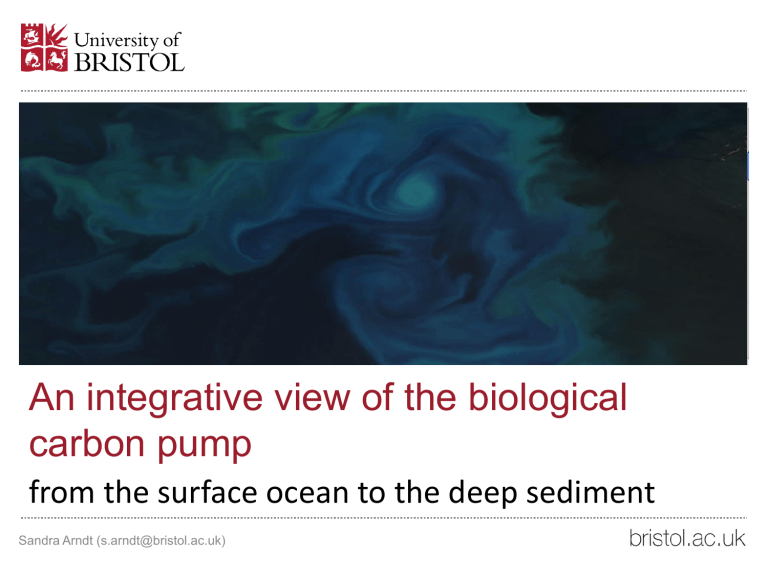An integrative view of the biological carbon pump

An integrative view of the biological carbon pump
from the surface ocean to the deep sediment
Sandra Arndt (s.arndt@bristol.ac.uk)
The biological C pump
•Controls importance of global ocean & sediments as C sink (or source) temporal sequestration of C in deep ocean (very fast response)
CH
2
O burial (fast response) weathering-CaCO
3 burial (slow response)
•Controls atmospheric O
2
•Controls nutrient and O
2 distribution in the ocean
•Controls size of hydrocarbon reservoirs
Sandra Arndt (s.arndt@bristol.ac.uk)
Efficiency of the biological C pump
Euphotic/
Epipelagic zone (0-200m)
Mesopelagic zone
(200-1000m)
0 yrs
CH
2
O CaCO
3
Export flux
F export
=10-20% NPP F export
=100% NPP
10 -1 yrs
Bathypelagic zone
(1000-4000m)
Sandra Arndt (s.arndt@bristol.ac.uk)
0.28-30% F export
70% F export
Abyssopelagic zone
(4000-6000m)
Sediment
(0-10 3 -10 4 m)
<1-5% F export
Deposition flux
50% F export
10 3 yrs
<0.3% F export
Burial flux
13% F export
10 8 yrs
Spatial variability
Sandra Arndt (s.arndt@bristol.ac.uk)
Spatial variability- Global scale
Primary Production (gC m-2 yr-1) Export Efficiency P eff
=F export
/PP
Henson et al., 2012
Transfer Efficiency T eff
=F
2000m
/F export
Henson et al., 2012
Sediment TOC (wt%)
Sandra Arndt (s.arndt@bristol.ac.uk)
Henson et al., 2012
Seiter et al., 2004
Spatial variability- Global scale
Regional patterns of organic matter quality in surface sediments
Sandra Arndt (s.arndt@bristol.ac.uk)
Arndt et al., ESR, in press
Spatial variability- Global scale
NO
3 flux
(mmol m-2 yr-1)
Seiter et al., 2005 PO
4 flux
(mmol m-2 yr-1)
Sandra Arndt (s.arndt@bristol.ac.uk)
Hensen et al., 1998
Spatial variability- Continental Margin
Lateral transport
Sandra Arndt (s.arndt@bristol.ac.uk)
Arndt et al., in press
Mollenhauer and Eglinton, 2007
Spatial variability- Lateral Transport
Marine-dominated inner shelf
Terrestrial mud dominated mid-shelf mudbelt
Starved outer shelf and continental slope
Schmidt et al., 2007
Sandra Arndt (s.arndt@bristol.ac.uk)
Spatial Variability- Continental Margin
Sediments are the ultimate sediment trap!
Sandra Arndt (s.arndt@bristol.ac.uk)
Zabel and Hensen, 2006
(modified from Jahnke, 1990)
Continental Margins-Spatial Variability
Sandra Arndt (s.arndt@bristol.ac.uk) unpublished data
Temporal variability
Sandra Arndt (s.arndt@bristol.ac.uk)
Temporal variability-Seasonal variability
Seasonal variability NPP:
Low: Equ. low productivity regions
High: high latitudes, monsoonal and temperate high productivity regions
Balance between seasonality of flux and production reverses with latitude
Sandra Arndt (s.arndt@bristol.ac.uk)
Lutz et al., 2007
Temporal variability-Seasonal variability
Seasonal variability in CH
2
O input results in a complex benthic response
Sandra Arndt (s.arndt@bristol.ac.uk)
Soetaert et al., 1996
Temporal variability-Lessons from the past
Example: 1. Pliocene-Pleistocene Transition at Bowers Ridge (Beringsea)
Sandra Arndt (s.arndt@bristol.ac.uk)
Temporal variability-Lessons from the past
Inverse diagenetic modeling of sediment porwater profiles…
…indicates peak in CH
2
O deposition flux & quality across transition and thus important changes in the functioning of the BCP
Wehrmann et al., 2013
Sandra Arndt (s.arndt@bristol.ac.uk)
Temporal variability-Lessons from the past
Example: 2. Cretaceous Oceanic Anoxic Event
Greenhouse climate, anoxic/sulfidic ocean
Sandra Arndt (s.arndt@bristol.ac.uk)
Temporal variability-Lessons from the past
Inverse diagenetic modeling of sediment porwater profiles indicates low reactivity (high preservation efficiency) and thus rapid transfer from surface ocean to deep sediment
Sandra Arndt (s.arndt@bristol.ac.uk)
Arndt et al., 2009
What causes the spatial-temporal variability?
The efficiency of the biological C pump is mainly driven by the production, transport and alteration of POC
Sandra Arndt (s.arndt@bristol.ac.uk)
What causes the spatial-temporal variability?
1. Ballasting
Model that partitions sinking CH
2
O in two fractions:
1) ballast associated
2) unassociated
Sarmiento and Gruber, 2006
Sandra Arndt (s.arndt@bristol.ac.uk)
What causes the spatial-temporal variability?
1. Ballasting
Spatial variability of CaCO3 carrying coefficients
Sandra Arndt (s.arndt@bristol.ac.uk)
Wilson et al., 2012
What causes the spatial-temporal variability?
2. Ecosystem Structure
Effect on transport Effect on quality
Mayor et al., 2012
Micklasz and Denny, 2010
Sandra Arndt (s.arndt@bristol.ac.uk)
What causes the spatial-temporal variability?
3. Organic matter source and transport
High quality:
Young marine material
Low quality:
Old marine material
Mix pre-aged, terrestrial material
Arndt et al., in press
Sandra Arndt (s.arndt@bristol.ac.uk)
Representation of the pump in Earth System Models
•Flux:
Simple power-law expression with constant scaling factor (Martin curve,
Martin, 1987):
F(z)
F exp
z z
0
b
Limit ability of models to predict response of the BCP to environmental perturbations and climate change
•no sediments
Arndt et al., in press
(adapted from lutz et al., 2002)
Sandra Arndt (s.arndt@bristol.ac.uk)
Conclusions
Biological carbon pump is a complex set of interlinked processes that act along the surface ocean- deep sediment continuum
Its functioning and efficiency is highly variable in time and space with important implications for global climate and biogeochemical cycles
Existing Earth system models include empirical, highly simplified and decoupled representations of the biological carbon pump that are not related to factors that control the quantity and quality of the flux
Sandra Arndt (s.arndt@bristol.ac.uk)
Thank you!
Sandra Arndt (s.arndt@bristol.ac.uk)







